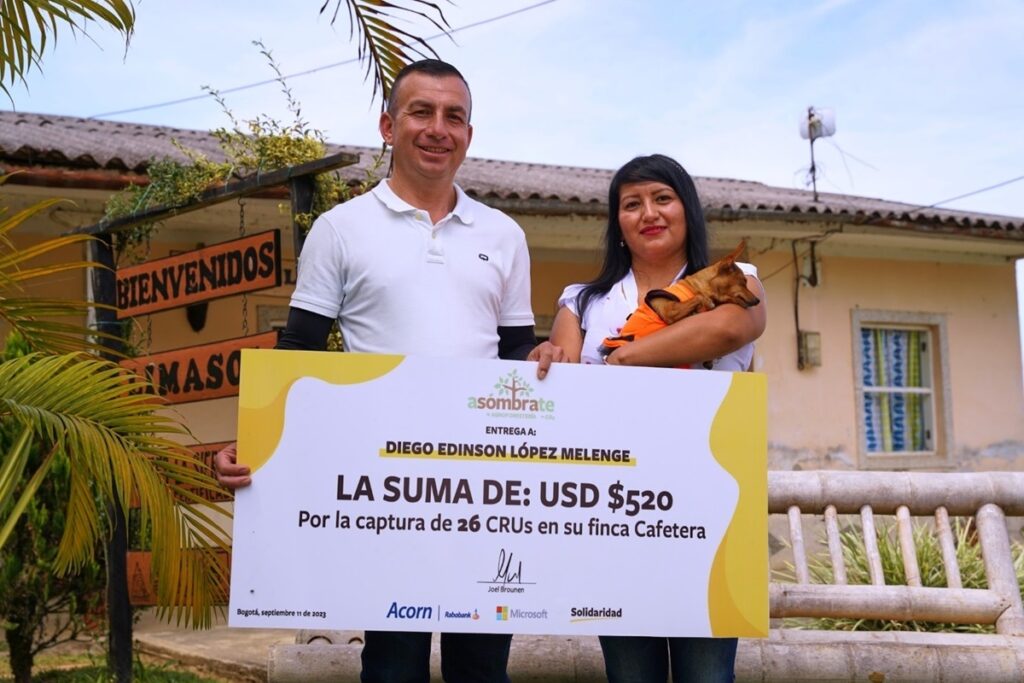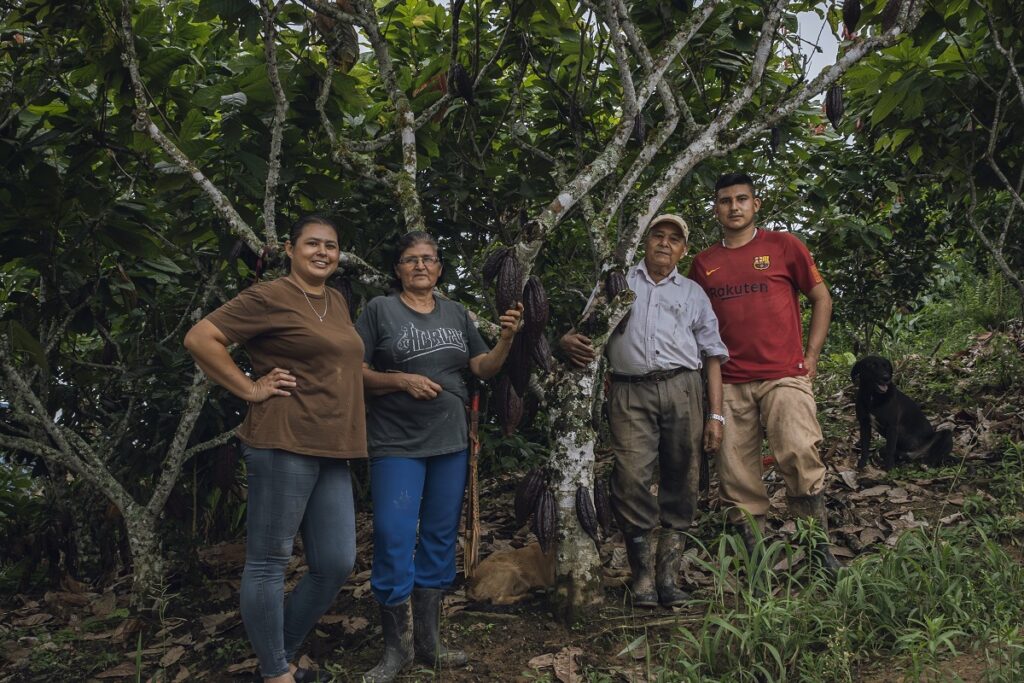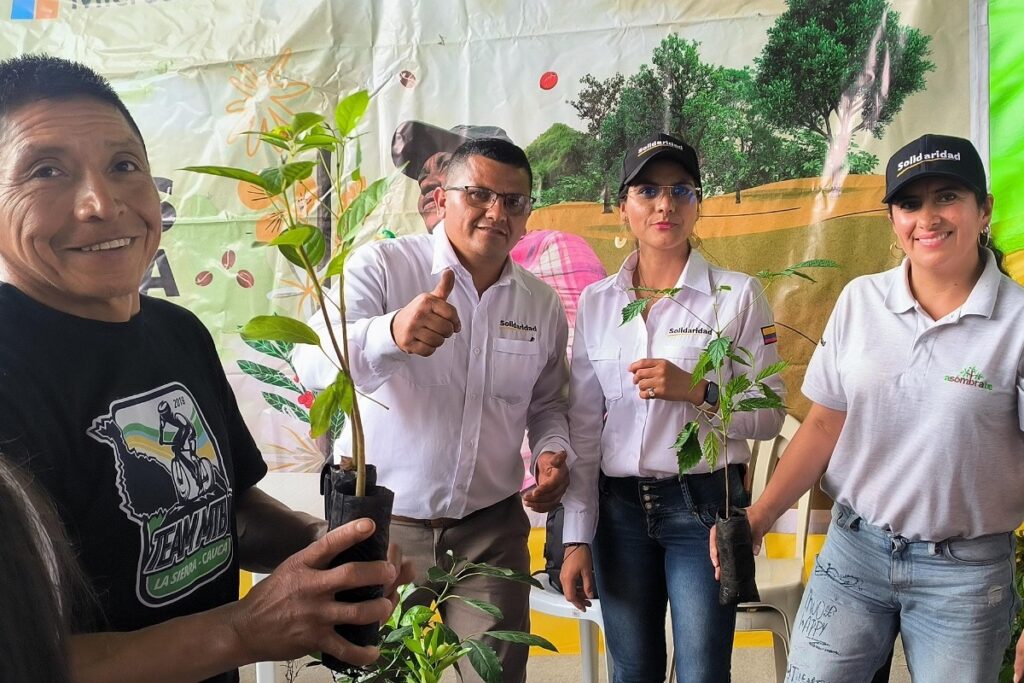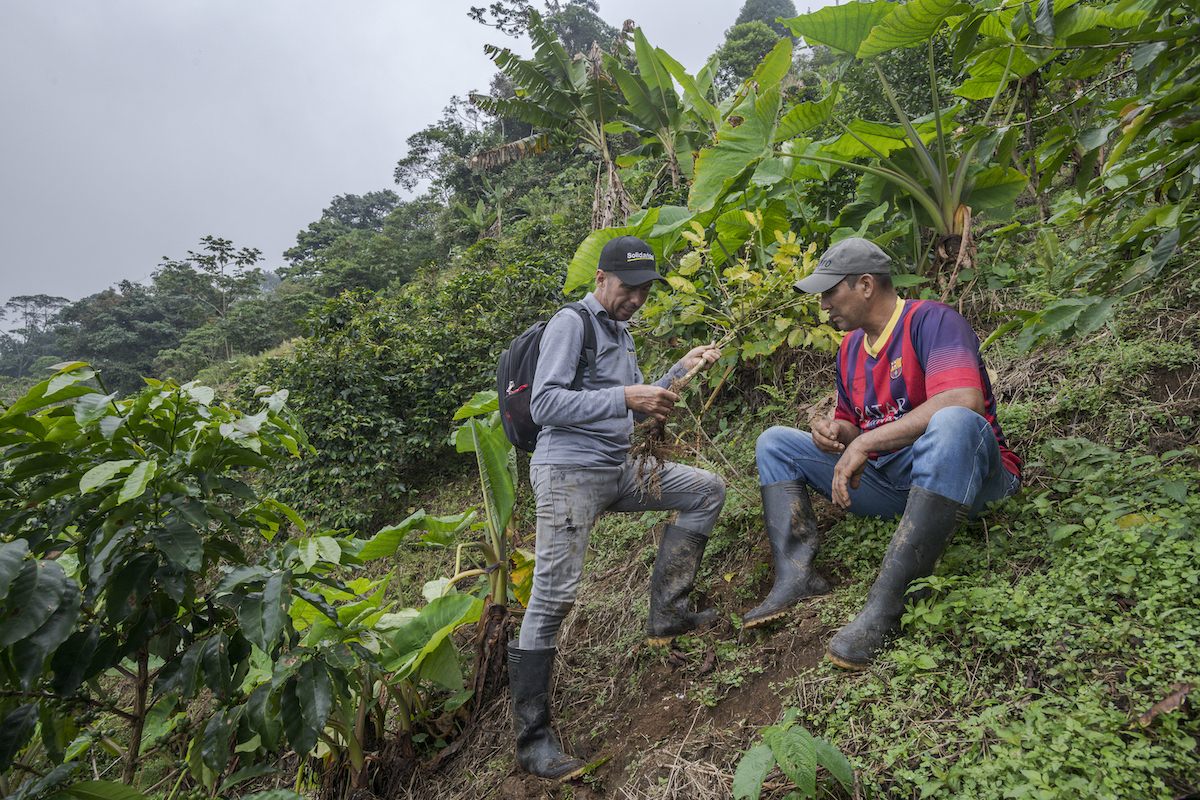Discussing the benefits of agroforestry and carbon credits.
“Asómbrate” – a combination of the Spanish words “asombrar” or astonish, and “sombra” meaning shade – is the title of a song created to promote the initiative in Colombia. The primary goal of the Asómbrate programme is to support farmers as they shift the way cocoa and coffee are cultivated to contribute to climate action (adaptation and mitigation), and recognize these efforts with access to carbon markets.
As of July 2024, nearly 30,000 coffee and cocoa farmers in Colombia have implemented agroforestry systems across more than 50,000 hectares. For small-scale farmers, these practices help them improve their production and livelihoods and the payments for environmental services represent an acknowledgement of their work to adapt to climate change.
Diego, his wife Yuliet and their son have a farm near La Sierra, a small village that’s a bumpy two-hour drive from Popayán, Colombia. Their three-hectare farm is tucked away between citrus and palm trees where they have worked the land for the past 12 years.
When Diego and Yuliet received their first payment for their carbon sequestration in fall of 2023, they were astonished: they had sequestered 26 tonnes of carbon on those 3 hectares of land – and earned roughly the equivalent of 475 euros in the process.

That same year, prior to the payment, Yuliet had been hospitalized for two months and the family had to use money they had saved for farm inputs to aid her recovery. The carbon capture payment helped them cover their expenses.
In the town of Rionegro in the department of Santander, Florinda Mieles and her husband Ramón Marín breathe in the mountain air which is filled with the aromas of cocoa, citrus and native trees growing on their farm of 4.5 hectares. They arrived in the area 14 years ago, fleeing the violence that gripped so many rural areas in Colombia.
“When we got here, the farm was pretty neglected. The house was very small and the crops were uncared-for. There was nothing to harvest, the trees had not been pruned,” remembers Florinda.

However, the 1,500 cocoa trees on the property offered an opportunity. With technical support from the Colombian Cocoa Growers Federation (Fedecacao) they began pruning the trees and doing soil analyses.
“That’s how we started to recover the cocoa farm. Trees are necessary because they give shade to the crops,” says Florinda. For her, the shade trees are a lifeline, since selling her cocoa beans every two weeks, or even every month, is a great support for the family.
Mariela Pabón, another cocoa grower, shares a similar opinion: “Without shade you cannot grow crops because now the climate has changed a lot. The sun is too hot; then the bushes start to have many diseases and they go bad.”
Florinda recently became the 20,000th participant in the Asómbrate programme in Colombia, while Mariela invested her extra income in fertilizers.
Agroforestry: the basis of Asómbrate
Agroforestry refers to a range of land-use systems that integrate trees and shrubs among agricultural crops and/or animals. Agroforestry is particularly suitable for crops such as coffee and cocoa, which thrive in the shade of other trees. Farmers who implement agroforestry practices can gain several benefits:
- By combining different plant species that have different nutritional needs, farmers take advantage of soil nutrients. For example, some trees can fix nitrogen, which enriches the soil and provides food for other plants.
- Shade trees protect coffee and cocoa plants helping to nourish them and resulting in a better harvest and a higher selling price.
- Farmers can also plant a combination of crops, such as fruits, vegetables, or medicinal plants among the coffee and cocoa, and that can both diversify incomes and improve the family diet.
Agroforestry systems can also positively impact biodiversity, from soil microorganisms to birds and mammals that contribute to the ecosystem through pollination and pest regulation. Finally, payments for carbon sequestration provides an additional financial incentive for small-scale farmers who adopt these practices.

How carbon markets can work for small-scale farmers
Carbon credits are one way to assign value to actions that reduce, remove, or avoid greenhouse gas (GHG) emissions and scale up climate action. A carbon credit represents a reduction of one metric tonne of GHG emissions, which can be bought and sold on carbon markets. A Carbon Removal Unit (CRU) is a type of carbon credit that effectively removes carbon from the atmosphere. This can be done through practices like low-carbon farming, agroforestry or forest restoration that comply with a certified framework and methodology and are verified by an independent third party.
The Dutch cooperative bank Rabobank established a platform called ACORN (Agroforestry Carbon Removals for the Organic Restoration of Nature). It teamed up with Solidaridad in Colombia to successfully pilot the platform among coffee farmers with agroforestry systems. The “Asombrate” programme in Colombia supports small-holder farmers with access to the ACORN platform, enabling small-scale farmers to sell their carbon removals for a fairer price on voluntary carbon markets that were previously out of reach.
The Acorn platform has strict requirements for purchasing carbon credits. Buyers are required to have a due diligence process in place, comply with the Rabobank Sustainability Statement, and have at least one of the following measures in place:
- A committed science-based target (SBTi) aligned to limiting a global temperature increase to 1.5 degrees;
- A written strategy in place to reduce their greenhouse gas emissions (publicly available or available to Rabobank);
- Proven greenhouse gas reduction (publicly available or available to Rabobank).
ACORN is able to offer farmers a higher percentage of the carbon credit value by leveraging advances in technology to reduce costs in the measurement and certification of captured CO2and associated transaction costs. This allows Rabobank to cover its costs with just 10 percent of the CRU sale value and ensure that more money goes directly to the producer. The ACORN platform guarantees a minimum price of 20 euros per metric tonne of CO2 removed and transfers 80 percent of the sale value directly to the producer’s pocket. The remaining 10 percent of the CRU sale value provides funding for training farmers through the Carbon Farming Academy, technical support to develop new agroforestry systems and improve existing ones, and to monitor coffee and cocoa cropland to evaluate carbon removal.
The partnership between Rabobank and Solidaridad is a breakthrough for smallholders to access carbon markets.
Joel Brounen, Country Manager for Solidaridad Colombia
“The use of technology has drastically reduced the transactions for individual farmers to measure the carbon removals on their farm. Moreover, Asombrate ensures that 80 percent of the sales value flows back to the farmer, making it the most inclusive option for smallholders in Colombia,” highlights Joel Brounen, Country Manager for Solidaridad Colombia.
For every hectare planted under agroforestry systems, a small-scale producer can capture on average between four and six metric tonnes of carbon per year. Once a year, Rabobank uses the Acorn platform to determine how much carbon individual farms have sequestered, and payments are determined accordingly. The first payment is usually made after three years when the trees are large enough to be detected by satellites. However, existing trees can also be credited retroactively for up to five years if it can be proven that the trees were planted with the aim of generating CO2 certificates and the smallholders received external support. These annual sales can extend for 10 to 15 years.
“The characteristics of the farms and agroforestry depend on the specific geographical, agronomic and economic conditions. Due to the great differences between farms, regions and crop cycle the suggested solutions may vary per farm, but ultimately the farmer is the person that takes the decision what solution to apply”, adds Joel Brounen “Coffee farmers remain coffee farmers, cocoa farmers remain cocoa farmers. The agroforestry systems are integrated with their main crop allowing smallholder farmers to optimize their farm productivity and production costs, to reduce climate risks and to access additional revenue streams for mitigation efforts.”
Requirements to Join Asómbrate
To be eligible to join Asómbrate, a farmer must meet the following criteria:
- Produce coffee or cocoa in agroforestry systems
- Own between 0.5 and 10 hectares of land
- Be the owner or able to demonstrate land tenure
- Have trees in their crop that have been planted five or fewer years ago
- Have a farm located in one of the regions where Solidaridad operates
- And importantly, not be linked to any other carbon capture sales scheme

